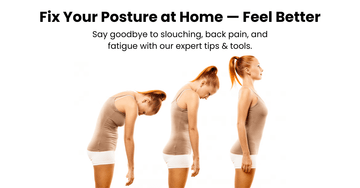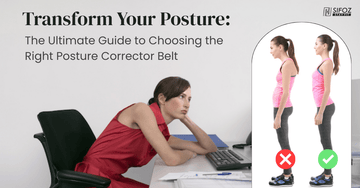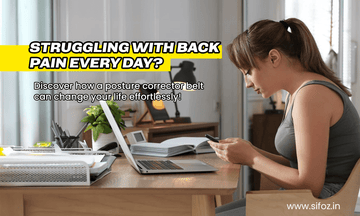Poor posture isn’t just about how you look-it can lead to serious back pain, fatigue, and long-term health issues. Whether you sit at a desk all day or spend hours on your phone, your body slowly adapts to bad habits. The good news? You can fix your posture at home using simple, effective techniques. In this guide, you’ll learn how to improve your posture naturally, the best posture corrector tools to support you, and daily habits that make a lasting difference.
Here’s everything you need to know about correcting your posture fast and effectively.
✅ Why Good Posture Matters
Posture affects how your body functions, from your spine and muscles to your breathing and digestion. When your body is aligned correctly:
-
You breathe better
-
Your muscles experience less strain
-
You reduce the risk of chronic pain
-
You feel more confident and energized
🚨 Common Signs of Poor Posture
You may not even realize your posture is causing issues. Here are red flags to watch out for:
-
Slouching or rounded shoulders
-
Forward head posture (“text neck”)
-
Frequent neck or lower back pain
-
Headaches or fatigue
-
Hunched upper back
-
Uneven hips or shoulders
💡 5 Easy Ways to Fix Your Posture (Starting Today)
Let’s make posture correction simple. These tips can be added to your daily routine without spending hours at the gym.
1. Strengthen Your Core
A strong core supports your spine and helps you maintain an upright posture.
Try This:
-
Planks
-
Bird-dog exercises
-
Pelvic tilts

Just 10 minutes a day can improve posture noticeably.
2. Stretch Tight Muscles
Tight muscles—especially in the chest and hips-can pull your body forward. Daily stretching keeps your body aligned.
Target Areas:
-
Chest (doorway stretches)
-
Shoulders
-
Hip flexors
-
Hamstrings
3. Use a Posture Corrector
For faster and more noticeable results, try wearing a posture corrector to support your back and shoulders.
👉 Shop Our Best-Selling Posture Corrector Belt - Comfortable, breathable & adjustable for daily use.
Wear it for 30–60 minutes a day to gently retrain your posture and avoid slouching.
4. Fix Your Desk Setup
Spending long hours at a computer? Here’s how to optimize your workspace:
-
Keep the monitor at eye level
-
Use an ergonomic chair
-
Support your lower back
-
Keep feet flat on the floor
-
Stand and stretch regularly

Bonus Tool: Ergonomic Back Support Cushion - Adds comfort and posture support for long sitting hours.
5. Build Posture Awareness
Daily posture checks help reinforce the habit.
Try This:
-
Wall posture test (head, shoulders, and hips against the wall)
-
Set hourly phone reminders
-
Use your phone camera to self-correct

✨ The Long-Term Benefits of Good Posture
Fixing your posture can help you:
-
Say goodbye to back and neck pain
-
Feel more confident
-
Improve energy levels
-
Strengthen your core and back muscles
🧘 Final Thoughts
Good posture isn’t about perfection, it’s about consistency. With small daily changes and the right tools, you can feel stronger, more aligned, and pain-free.
Frequently Asked Questions (FAQs)
Q1: What is the fastest way to fix bad posture at home?
A: The fastest way to fix bad posture at home is by combining daily posture exercises, stretching tight muscles, and using a posture corrector belt for short periods. Consistency and awareness are key to long-term posture improvement.
Q2: Are posture corrector belts effective?
A: Yes, posture corrector belts are effective when used correctly. They help realign the spine, reduce slouching, and train your muscles to hold a better posture. However, they should be used as a support tool—not a permanent solution.
Q3: How long should I wear a posture corrector each day?
A: It's recommended to wear a posture corrector for 30 to 60 minutes a day. Overuse may cause your muscles to rely on the device. Start slow and combine it with strengthening exercises for best results.
Q4: Can bad posture cause back and neck pain?
A: Absolutely. Poor posture puts extra strain on your spine and muscles, leading to chronic neck, shoulder, and lower back pain. Correcting your posture can significantly reduce pain and prevent future injuries.




